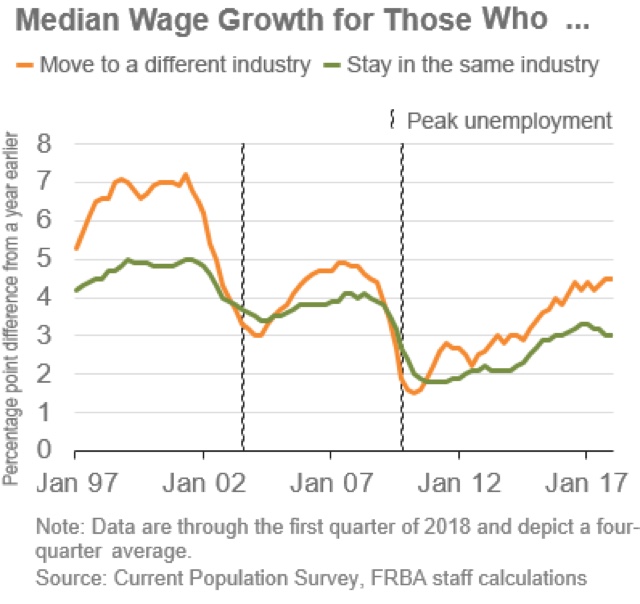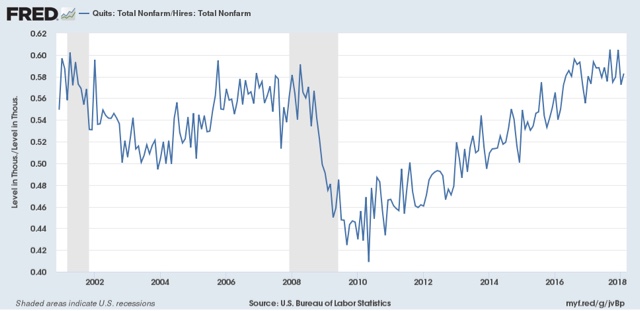Summary:
Higher wage growth for job switchers: more evidence of a taboo against raising wages? Yesterday the Atlanta Fed published a note touting the wage growth for those who quit their jobs and transfer to a different line of work, writing that: Although wages haven’t been rising faster for the median individual, they have been for those who switch jobs. This distinction is important because the wage growth of job-switchers tends to be a better cyclical indicator than overall wage growth. In particular, the median wage growth of people who change industry or occupation tends to rise more rapidly as the labor market tightens. The following graph was posted in support of this point: Essentially the Atlanta Fed is highlighting the orange line as a “better
Topics:
NewDealdemocrat considers the following as important: Taxes/regulation, US/Global Economics
This could be interesting, too:
Higher wage growth for job switchers: more evidence of a taboo against raising wages? Yesterday the Atlanta Fed published a note touting the wage growth for those who quit their jobs and transfer to a different line of work, writing that: Although wages haven’t been rising faster for the median individual, they have been for those who switch jobs. This distinction is important because the wage growth of job-switchers tends to be a better cyclical indicator than overall wage growth. In particular, the median wage growth of people who change industry or occupation tends to rise more rapidly as the labor market tightens. The following graph was posted in support of this point: Essentially the Atlanta Fed is highlighting the orange line as a “better
Topics:
NewDealdemocrat considers the following as important: Taxes/regulation, US/Global Economics
This could be interesting, too:
Joel Eissenberg writes How Tesla makes money
Angry Bear writes True pricing: effects on competition
Angry Bear writes The paradox of economic competition
Angry Bear writes USMAC Exempts Certain Items Coming out of Mexico and Canada
Higher wage growth for job switchers: more evidence of a taboo against raising wages?
Yesterday the Atlanta Fed published a note touting the wage growth for those who quit their jobs and transfer to a different line of work, writing that:
Although wages haven’t been rising faster for the median individual, they have been for those who switch jobs. This distinction is important because the wage growth of job-switchers tends to be a better cyclical indicator than overall wage growth. In particular, the median wage growth of people who change industry or occupation tends to rise more rapidly as the labor market tightens.
The following graph was posted in support of this point:
Essentially the Atlanta Fed is highlighting the orange line as a “better cyclical indicator.”
Is it? There’s no doubt that wage growth among job switches declined first in the last two expansions. But I would want to see a much longer record before being that confident.
Because what I see in the above graph is a decline among job keepers (the green line) that is only matched by those declines presaging the onset of the last two recessions. Meanwhile the orange line, while still rising, has flattened.
In fact I think the Atlanta Fed’s graph mainly shows evidence of what I highlighted last week as an emerging “taboo” against raising wages — i.e., a stubborn refusal to raise wages even if it would lead to even higher output and gross profits for a net gain.
Once again the JOLTS data gives us a good proxy. If wage growth is increasing at a “normal” rate compared with previous expansions, there shouldn’t be an inordinate need to change jobs in order to get a raise, i.e., a rate higher than previous expansions. Thus the ratio of job changers who quit vs. the number of actual hires should be equivalent to similar stages in those expansions. If, on the other hand, employers have become inordinately stingy, quitting is almost essential to get ahead, in which case the ratio of quits to hires should be higher than normal.
Here is what the data shows:
For the last several years, Quits have been in the range of 58%-60% of hires, the highest since 2001, and specifically higher than the 56%-58% peak of the last expansion.
In other words, it looks like what the Atlanta Fed’s graph is showing is that employees are reacting to the taboo against raising wages by quitting their jobs and moving to employers in fields that are already paying more.


